Pittosporum is a genus of evergreen shrubs or small trees that are popular for landscaping. They have glossy, leathery leaves that come in various shapes, colors, and sizes. Some varieties also have fragrant flowers that attract bees and butterflies. Pittosporum plants are easy to grow and care for, as they are adaptable to different soil types, light levels, and climates. Here is some information on how to grow pittosporum in your home garden.
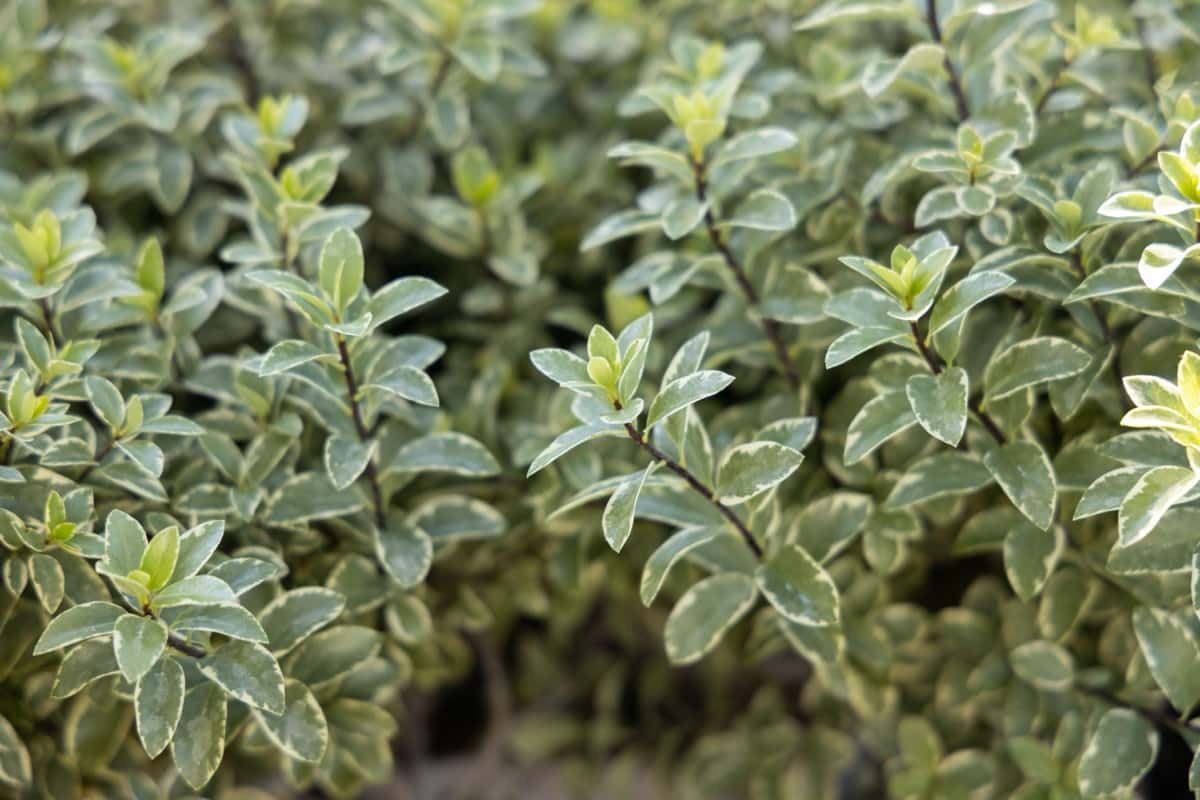
How to Grow Pittosporum
About Pittosporum
Pittosporum plants are native to Australasia, Oceania, eastern Asia, and some parts of Africa. They belong to the family Pittosporaceae, which is closely related to the carrot family. The name pittosporum comes from the Greek words for “pitch” and “seed,” referring to the sticky resin that coats the seeds. Pittosporum plants are also known as mock orange, cheesewood, or Japanese pittosporum, depending on the species.
Pittosporum Varieties: Choosing the Best One for Your Garden
Pittosporum is a plant that can be grown in various ways depending on the gardener’s style, space, and preferences. Some popular varieties include Pittosporum tenuifolium, which can grow up to 10 meters and has thin, black stems and small, oval leaves. It produces fragrant white, pink, or red flowers and is cultivated by various names. Pittosporum tobira, a slow-growing species, can grow up to 5 meters and has thick, gray-green stems and glossy leaves. It produces fragrant white, orange-blossom-like flowers and is cultivated by various names.
Pittosporum crassifolium, a medium-growing species, can grow up to 6 meters and has gray-brown stems and thick, leathery leaves. It produces fragrant red or purple flowers and is cultivated by various names. Pittosporum eugenioides, a medium-growing species, can grow up to 8 meters and has smooth, green stems and thin, wavy leaves. It produces fragrant yellow or cream flowers and is cultivated by various names.
The Best Soil Conditions for Pittosporum
Pittosporum plants thrive in well-drained, rich soil. They need slightly acidic to neutral soil pH but may survive alkaline soils. Before planting, apply compost, manure, or leaf mold to enhance soil quality. Mulching around plants conserves moisture and prevents weeds.
In case you missed it: How to Grow a Finger Lime Tree: Planting, Propagation, Care for Citrus Australasica/Caviar Lime
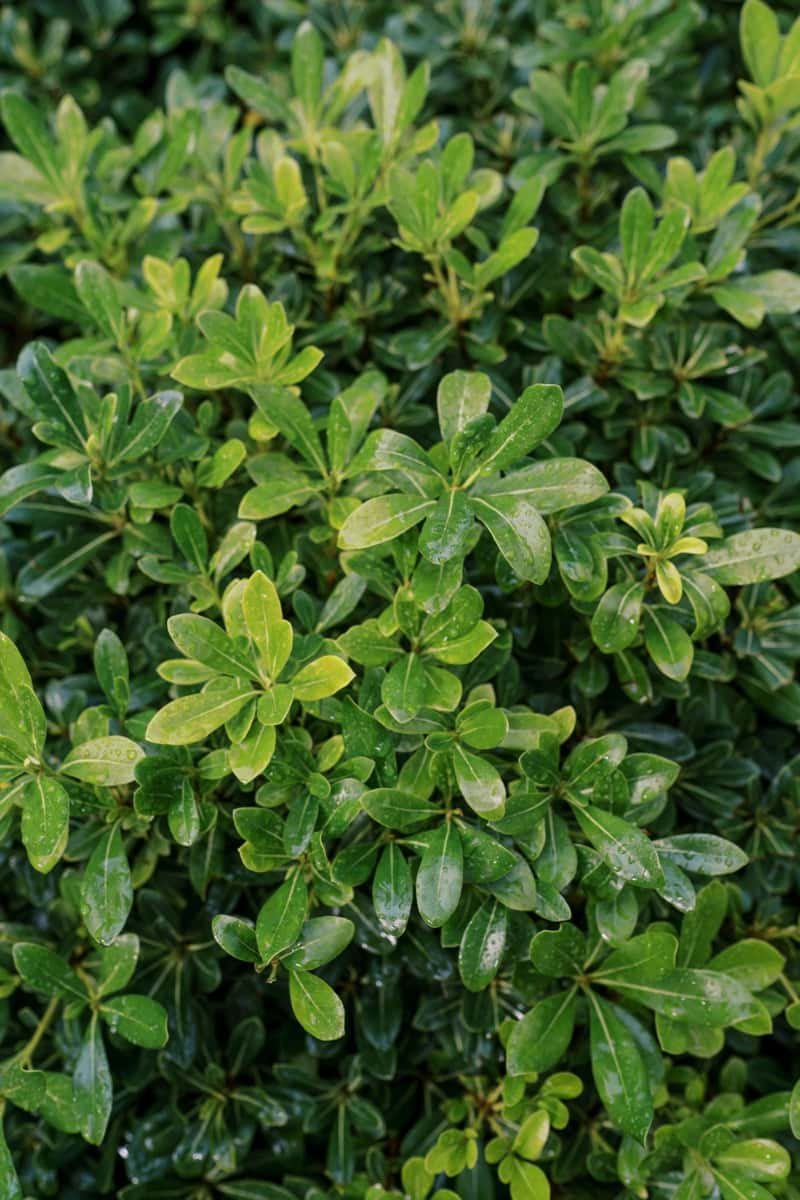
Growing Pittosporum: A Comprehensive Guide for Beginners
- Pittosporums, with their scented flowers and beautiful foliage, are easy to grow and ideal for hedges and borders.
- The genus comprises around 200 species, mostly native to Japan and Southeast Asia, reaching a height of 2-3 meters after steady growth.
- USDA Zones: 8-11; Difficulty: Easy; Other Names: Karo, Stiffleaf Cheesewood, Japanese pittosporum.
Understanding Pittosporum Tobira
- Pittosporum Tobira is an evergreen plant with leathery, oval, bright green leaves.
- Flowers vary in color (white, cream, yellow, red, or brown) and emit a pleasant citrus-like fragrance.
- Common Varieties: Pittosporum tobira, tenuifolium, crassifolium, eugenioides.
Growing and Propagating Pittosporum
- Propagation: Easily done through cuttings (8-15 cm), preferably from a nursery plant.
- Planting: In heavy soil, mix with sand, compost, and slow-release fertilizer. For pots, use quality potting mix.
Caring for Pittosporum
- Position: Outdoor in partial sun; protect from extreme weather conditions.
- Watering: Keep soil slightly moist; reduce in winter to avoid overwatering.
- Soil: Well-drained, loamy, slightly acidic to neutral.
- Fertilizer: Apply a balanced slow-release fertilizer in spring; mulch with composted leaves.
- Pruning: Light trimming to maintain shape and size; heavy pruning after blooming.
- Pests and Diseases: Regularly inspect for aphids, red spider mites, cushion scales, and pittosporum suckers.
How to Plant Pittosporum in Your Home Garden
Pittosporum plants can be planted in spring or autumn, depending on your climate. Choose a location that receives full sun or partial shade, depending on the variety. Avoid planting them in windy or frost-prone areas, as cold or dry conditions can damage them. Dig a hole twice deep as the root ball of the plant and place it in the center. Fill the hole with soil and water well. Space the plants 1 to 3 m (3 to 10 ft) apart, depending on the variety and the desired effect.
How and When to Water Pittosporum in the Garden
Pittosporum plants are drought-tolerant once established, but they need regular watering during their first year of growth. Water them deeply and thoroughly once a week or more often during hot or dry weather. Reduce watering frequency in winter or rainy seasons. Avoid overwatering or waterlogging the soil, as this can cause root rot or fungal diseases.
In case you missed it: Grape Farming in the Philippines: How to Plant and Grow Grapes in Filipino Soil, Cost, and Profit
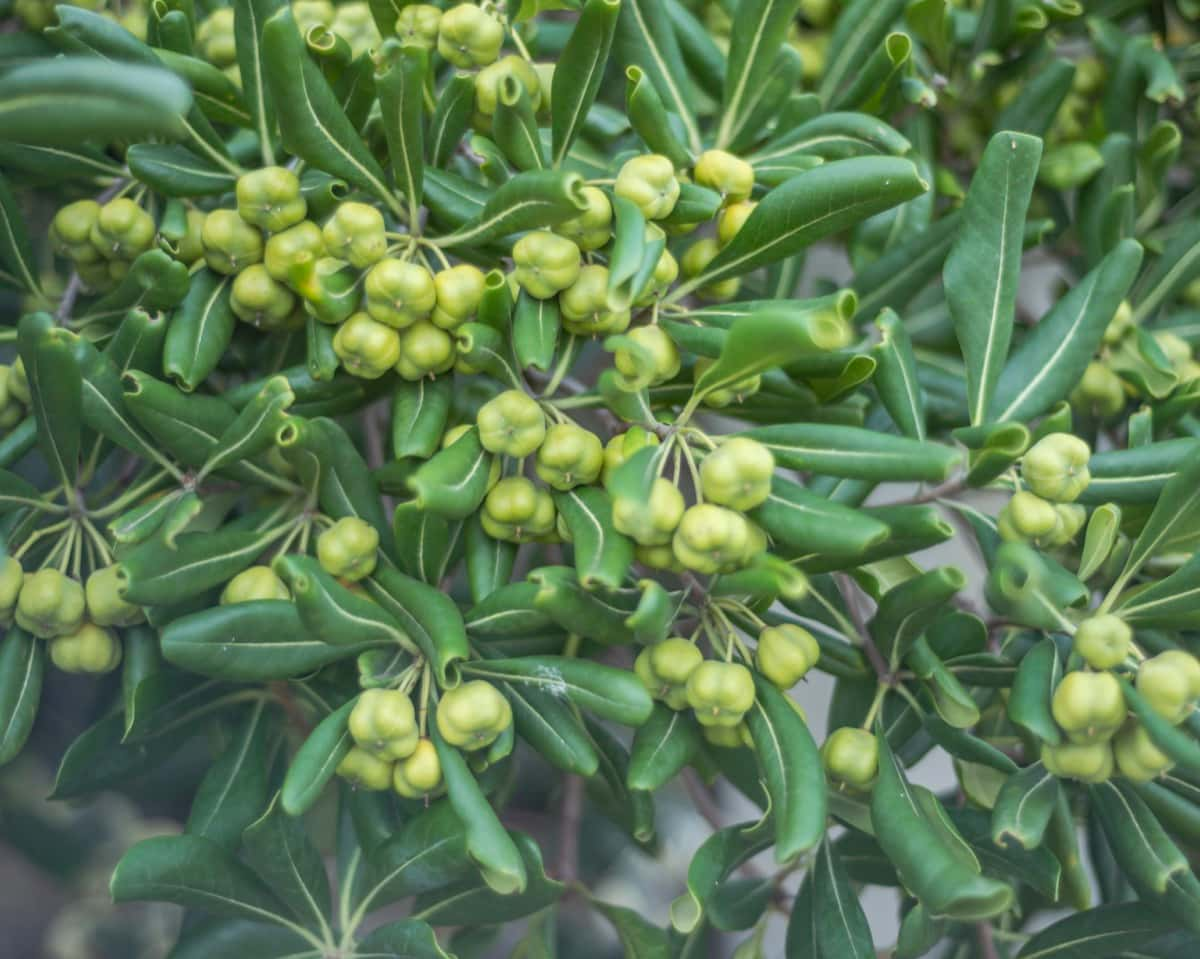
The Best Fertilizers for Pittosporum Plants: When and How to Apply
Pittosporum plants do not need much fertilization, as they can grow well in poor soils. However, you can apply a balanced fertilizer 10-10-10 or an organic fertilizer like fish emulsion or seaweed extract once or twice a year, in spring and summer. Follow the instructions on the label and do not overfeed the plants, as this can cause excessive growth or leaf burn.
How to Prune Pittosporum to Maintain Shape and Health
Pittosporum plants can be pruned to shape them, control their size, or remove dead or diseased branches. Pruning can be done any time of the year, but it is best to avoid pruning in late winter or early spring, as this can reduce flowering. Use sharp and clean pruning tools and make clean cuts at an angle, at a leaf node, or at a branch junction. Remove no more than one-third of the plant at a time and dispose of the cuttings properly.
Keeping Pittosporum Free from Pests and Diseases
Aphids are small, sap-sucking that can infest plants, causing distortion, curling, yellowing, or wilting of foliage. They can transmit viral diseases or produce honeydew, which attracts ants and sooty mold. Controlling aphids involves spraying them with water, insecticidal soap, neem oil, or horticultural oil. Scale insects are hard-shelled insects that attach to plants’ stems or leaves, causing yellowing, stunting, or dieback of foliage.
Mealybugs are small, white, cottony insects that cluster on plants’ stems or leaves, causing distortion, curling, yellowing, or wilting. Controlling mealybugs involves spraying them with water, alcohol, insecticidal soap, neem oil, or horticultural oil. Spider mites are tiny, spider-like, that live on the undersides of leaves, causing speckling, bronzing, or webbing of foliage.
Controlling spider mites involves spraying them with water, insecticidal soap, neem oil, or horticultural oil. Root rot affects plants’ roots, causing wilting, yellowing, or dropping of foliage. Preventing root rot involves moderate watering and good drainage while treating it involves removing the affected plant and replanting it in fresh soil.
Seasonal Care for Pittosporum: What to Do in Spring, Summer, Fall, and Winter
Pittosporum plants are evergreen plants that require minimal seasonal care. They thrive during spring, when they produce new growth and flowers and can be boosted with fertilizer and mulch. During summer, they are in full bloom, and regular watering and monitoring are essential.
Deadheading spent flowers can encourage more blooming. In fall, they slow down and prepare for winter, reducing watering frequency and fertilizing. Pruning to remove dead or diseased branches. Winter is a dormant period requiring minimal care. Watering sparingly when soil is dry and protecting it from frost or moving it indoors.
Landscaping with Pittosporum: Design Ideas for Your Garden
Pittosporum, a genus of evergreen shrubs and trees native to Asia, Africa, and Australia, is popular for landscaping due to its attractive foliage, fragrant flowers, and variety of shapes and sizes. Common species include Japanese mock orange (P. tobira), silver sheen (P. tenuifolium), and variegated Japanese cheesewood (P. undulatum).
In case you missed it: Thailand All Time Mango Farming: How to Plant and Grow Katimon Mango
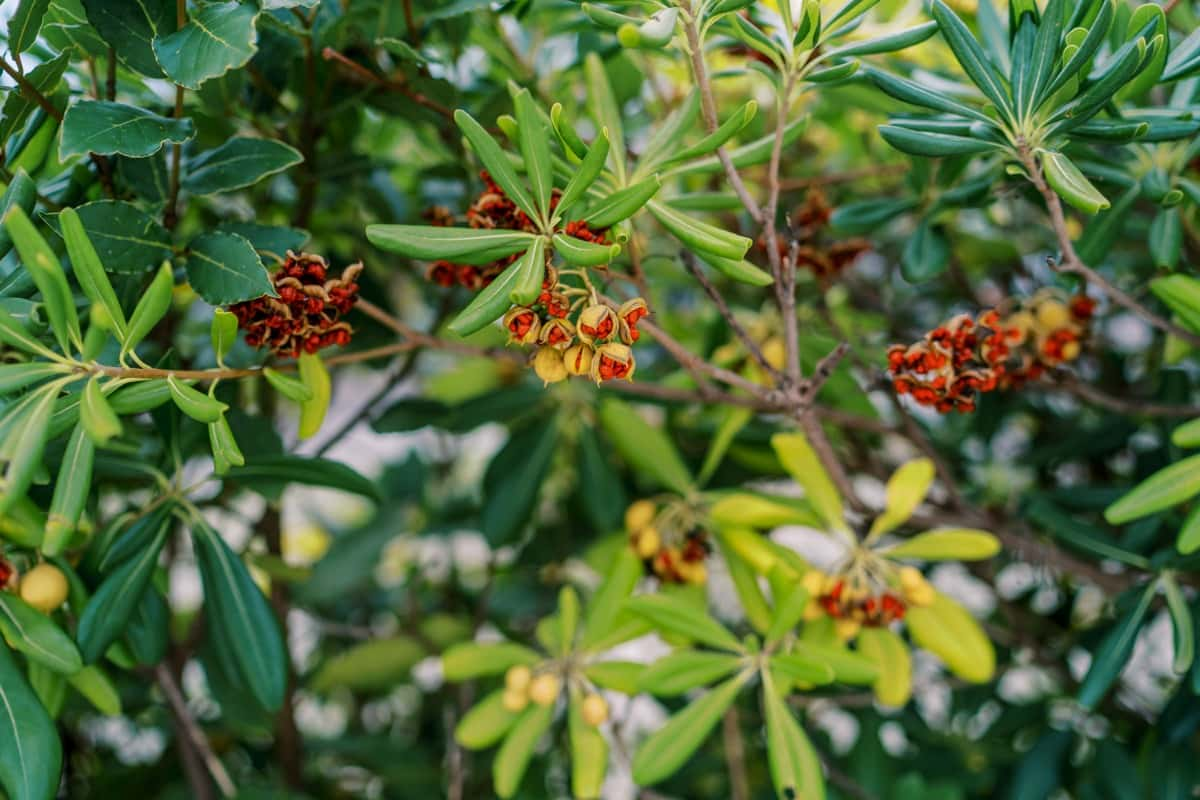
Pittosporum can be used as a hedge, a focal point, a backdrop for other plants, or a container plant for patios or balconies. Its colorful or variegated foliage can be used to create privacy and define boundaries. It can also be used as a filler for other plants, creating contrast and interest.
Propagation Methods for Pittosporum: Seeds vs Cuttings
Pittosporum can be propagated through seeds or cuttings, depending on the method chosen. Seeds are collected from ripe fruits in late summer or autumn and sowed directly in pots or trays with a moist potting mix. Seeds may take several weeks to germinate and may need stratification to improve germination rates.
Cuttings can be taken from the pittosporum in late summer or autumn, and 4-6 inch long stems with at least 3-4 nodes from healthy plants can be cut. Dip the cut ends in rooting hormone and place them in pots or trays filled with potting mix. Cuttings may root in 4-8 weeks and should be kept in a warm and humid environment.
Common Challenges When Growing Pittosporum and How to Overcome Them
Pittosporum plants can be easily grown and cared for, but they may face challenges from pests, diseases, and environmental factors. Pests include aphids, scale insects, mealybugs, spider mites, and thrips, which can be controlled by spraying them with insecticidal soap, neem oil, or horticultural oil or by releasing beneficial insects like ladybugs, lacewings, or parasitic wasps. Diseases like leaf spot, root rot, dieback, and powdery mildew can be prevented by maintaining healthy plants, avoiding over-fertilization, pruning dead or diseased branches, and providing good air circulation.
Environmental factors like frost, drought, heat, wind, salt spray, and poor soil conditions can stress pittosporum plants. To protect plants, cover them with frost cloth or move them indoors. To cope with drought, mulch and water deeply and infrequently. To shield plants from heat, provide shade during the hottest part of the day. To reduce wind damage, plant pittosporums in a sheltered location or create a windbreak.
Companion Planting with Pittosporum: Ideal Plant Partners
Pittosporum can be paired with various plants to create a harmonious or dynamic effect. Roses are classic companions for pittosporum, providing beautiful flowers and fragrance. Roses can be in various colors, textures, shapes, or sizes and can be used as climbers, shrubs, or miniatures. Lavender is an aromatic plant with purple flowers and gray-green foliage, suitable for bordering or accenting pittosporums. Hydrangeas are showy and provide large clusters of blue, pink, white, or purple flowers, suitable for acidic soil and serving as a backdrop or filler.
Grasses are textural companions, providing fine or coarse foliage and seed heads. They can contrast or complement pittosporum’s glossy leaves and create movement and sound in the garden. Some suitable grasses for pittosporum include fountain grass (Pennisetum), blue oat grass (Helictotrichon), and feather reed grass (Calamagrostis). These plants can attract bees and butterflies to your garden.
The Role of Sunlight: Finding the Perfect Spot for Your Pittosporum
Pittosporum is a sun-loving plant that thrives in full sun to partial shade. The ideal spot for your pittosporum depends on its species and variety. Full sun requires 6 hours of direct sunlight, which most species can tolerate, especially with well-watered and mulched plants. Partial shade requires 3-6 hours of direct sunlight per day, with some species tolerant, especially those with variegated foliage.
In case you missed it: How to Grow Fairy Castle Cactus Plants: Exploring Propagation, Planting, and Care
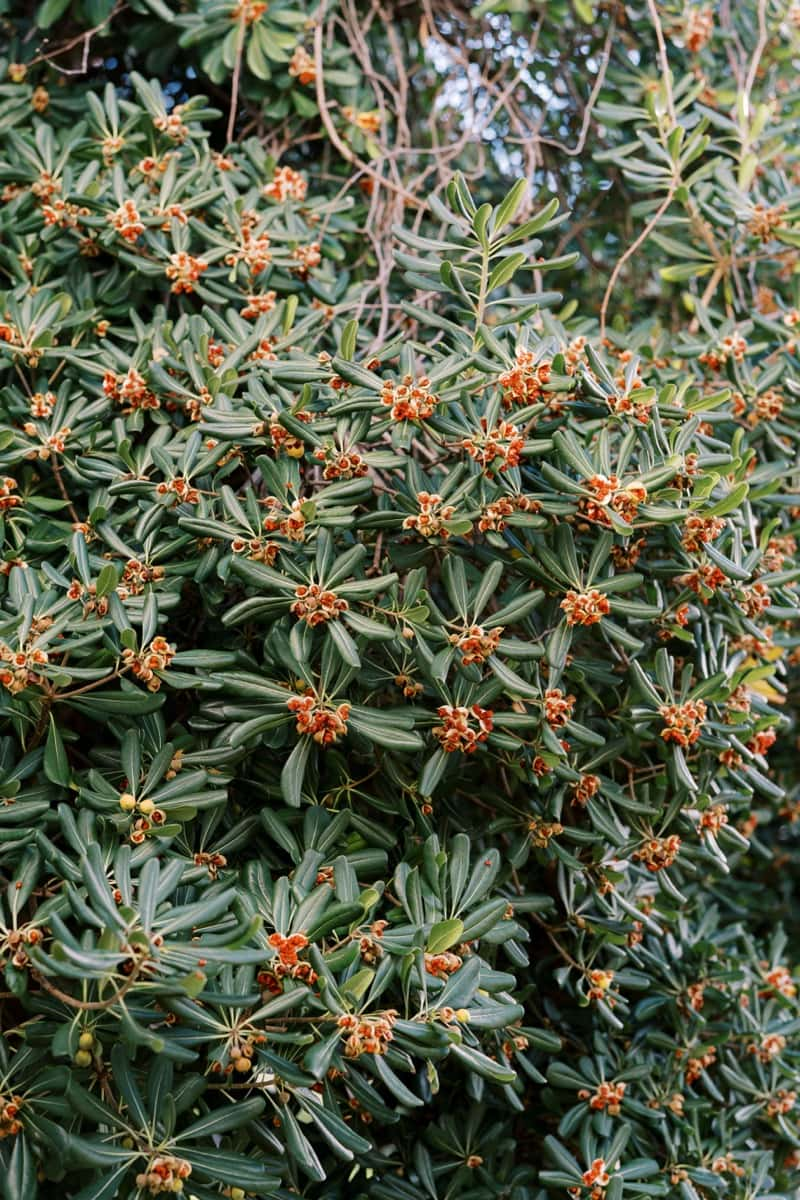
However, some may lose their variegation or become leggy in too much shade. Full shade requires less than 3 hours per day, but pittosporum is not a shade-loving plant and may become weak, spindly, and susceptible to pests and diseases.
How to Transplant Mature Pittosporum
Pittosporum tenuifolium, also known as kohuhu or black matipo, is a popular evergreen shrub or small tree in New Zealand. It has glossy green leaves, fragrant flowers, and attractive seed pods.
- Choose a suitable location for the transplant. The plant prefers a sheltered spot with moist, well-drained soil. Avoid planting it in areas with strong winds, frost, or waterlogging.
- Loosen the soil, add compost or manure to the planting hole. The plant should be gently dug up to preserve the root system. Lift the plant and adjust its depth and location. Fill gaps around the root ball with soil mixture and gently press down. Water the plant thoroughly to settle dirt and remove air pockets.
- Mulch the plant base to retain moisture and control weeds. Mulch bark chips, straw, or leaves away from the stem to avoid rotting. Trim the plant gently to shape it and remove unhealthy or broken branches.
- For the first year after transplanting, water the plant often, particularly in dry weather. Use a balanced fertilizer in spring and summer to stimulate growth and blooming. Avoid overwatering and fertilizing to prevent root rot and leaf burn.
In case you missed it: Everything You Want to Know About Wandering Jew Plant: Propagation, Growing, and Caring
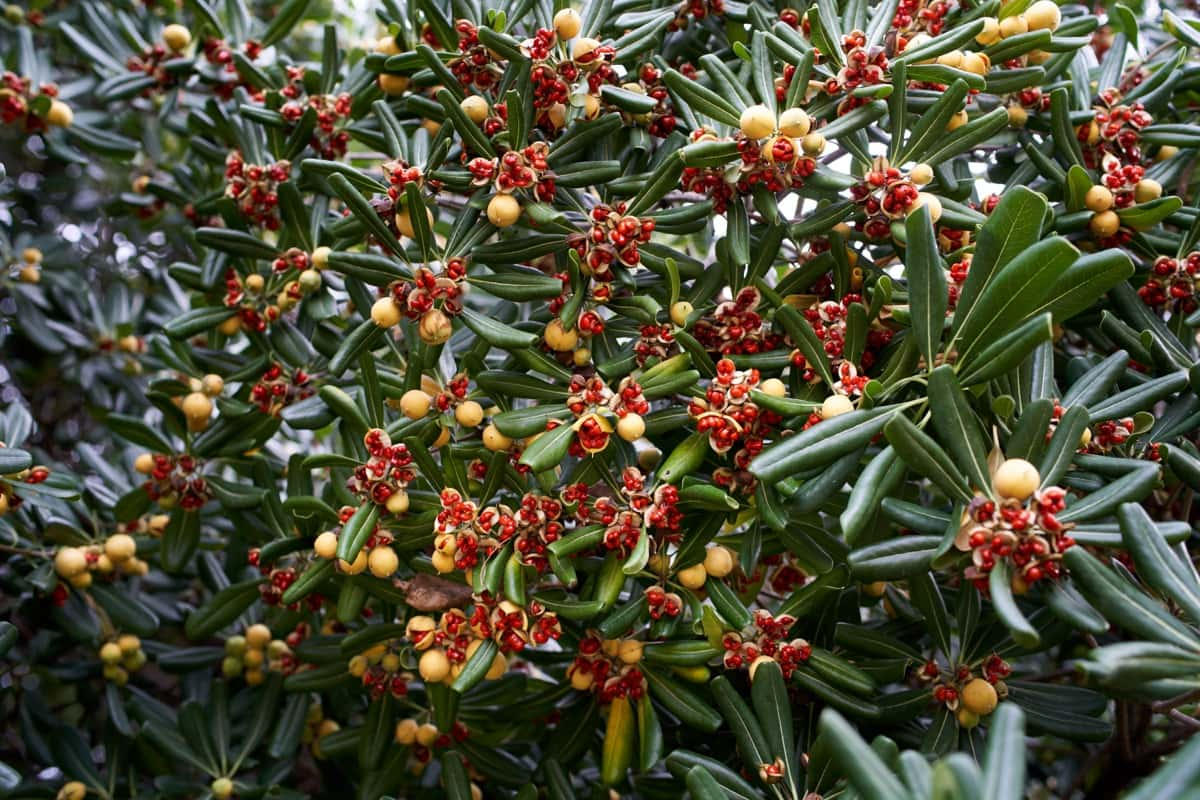
Conclusion
Growing Pittosporum is a rewarding experience for beginners, offering not only scented flowers but also lush foliage. From propagation to care, understanding the varieties and their specific needs ensures a thriving addition to your garden.
- Types of Pesticides Used in Agriculture: A Beginner’s Guide
- Economical Aquaculture: A Guide to Low-Budget Fish Farming
- 15 Common Planting Errors That Can Doom Your Fruit Trees
- How to Make Houseplants Bushy: Effective Tips and Ideas
- Innovative Strategies for Boosting Coconut Pollination and Yield
- Pollination Strategies for Maximum Pumpkin Yield
- The Complete Guide to Chicken Fattening: Strategies for Maximum Growth
- Natural Solutions for Tulip Problems: 100% Effective Remedies for Leaf and Bulb-Related Issues
- Revolutionizing Citrus Preservation: Towards a Healthier, Greener Future
- Natural Solutions for Peony Leaf and Flower Problems: 100% Effective Remedies
- Maximizing Profits with Avocado Contract Farming in India: A Comprehensive Guide
- Natural Solutions for Hydrangea Problems: 100% Effective Remedies for Leaf and Flowers
- The Ultimate Guide to Choosing the Perfect Foliage Friend: Bringing Life Indoors
- From Sunlight to Sustainability: 15 Ways to Use Solar Technology in Agriculture
- The Ultimate Guide to Dong Tao Chicken: Exploring from History to Raising
- The Eco-Friendly Makeover: How to Convert Your Unused Swimming Pool into a Fish Pond
- Mastering the Art of Delaware Chicken Farming: Essentials for Healthy Backyard Flocks
- 20 Best Homemade Fertilizers for Money Plant: DIY Recipes and Application Methods
- How to Craft a Comprehensive Free-Range Chicken Farming Business Plan
- Brighten Your Flock: Raising Easter Egger Chickens for Beauty and Bounty
- How to Optimize Your Poultry Egg Farm Business Plan with These Strategies
- Subsidy for Spirulina Cultivation: How Indian Government Schemes Encouraging Spirulina Farmers
- Ultimate Guide to Raising Dominique Chickens: Breeding, Feeding, Egg-Production, and Care
- Mastering the Art of Raising Jersey Giant Chickens: Care, Feeding, and More
- Ultimate Guide to Raising Legbar Chickens: Breeding, Farming Practices, Diet, Egg-Production
- How to Raise Welsummer Chickens: A Comprehensive Guide for Beginners
- How to Protect Indoor Plants in Winter: A Comprehensive Guide
- Ultimate Guide to Grow Bag Gardening: Tips, Tricks, and Planting Ideas for Urban Gardeners
- Guide to Lotus Cultivation: How to Propagate, Plant, Grow, Care, Cost, and Profit
- Agriculture Drone Subsidy Scheme: Government Kisan Subsidy, License, and How to Apply Online
- Ultimate Guide to Raising Araucana Chickens: Breed Profile, Farming Economics, Diet, and Care
- Bringing Hydroponics to Classroom: Importance, Benefits of Learning for School Students
- Ultimate Guide to Raising Polish Chickens: Breed Profile, Farming Economics, Diet, and Care
- Ultimate Guide to Raising Australorp Chickens: Profile, Farming Economics, Egg Production, Diet, and Care
- Silkie Chicken Farming: Raising Practices, Varieties, Egg Production, Diet, and Care
- Sussex Chicken Farming: Raising Practices, Varieties, Egg Production, Diet and Care